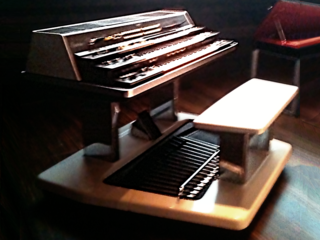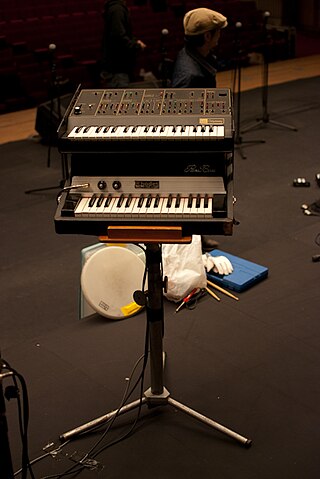Related Research Articles

The clavichord is a stringed rectangular keyboard instrument that was used largely in the Late Middle Ages, through the Renaissance, Baroque and Classical eras. Historically, it was mostly used as a practice instrument and as an aid to composition, not being loud enough for larger performances. The clavichord produces sound by striking brass or iron strings with small metal blades called tangents. Vibrations are transmitted through the bridge(s) to the soundboard.
In music, a glissando is a glide from one pitch to another. It is an Italianized musical term derived from the French glisser, "to glide". In some contexts, it is equivalent to portamento, which is a continuous, seamless glide between notes. In other contexts, it refers to discrete, stepped glides across notes, such as on a piano. Some terms that are similar or equivalent in some contexts are slide, sweepbend, smear, rip, lip, plop, or falling hail. On wind instruments, a scoop is a glissando ascending to the onset of a note achieved entirely with the embouchure, except on instruments that have a slide.
In music performance and notation, legato indicates that musical notes are played or sung smoothly and connected. That is, the player makes a transition from note to note with no intervening silence. Legato technique is required for slurred performance, but unlike slurring, legato does not forbid re-articulation.

In music, the organ is a keyboard instrument of one or more pipe divisions or other means for producing tones. The organs have usually two or three, up to five, manuals for playing with the hands and a pedalboard for playing with the feet. With the use of registers, several groups of pipes can be connected to one manual.

An electronic keyboard, portable keyboard, or digital keyboard is an electronic musical instrument based on keyboard instruments. Electronic keyboards include synthesizers, digital pianos, stage pianos, electronic organs and digital audio workstations. In technical terms, an electronic keyboard is a rompler-based synthesizer with a low-wattage power amplifier and small loudspeakers.
A variety of musical terms are encountered in printed scores, music reviews, and program notes. Most of the terms are Italian, in accordance with the Italian origins of many European musical conventions. Sometimes, the special musical meanings of these phrases differ from the original or current Italian meanings. Most of the other terms are taken from French and German, indicated by Fr. and Ger., respectively.

An electric organ, also known as electronic organ, is an electronic keyboard instrument which was derived from the harmonium, pipe organ and theatre organ. Originally designed to imitate their sound, or orchestral sounds, it has since developed into several types of instruments:

A pedalboard is a keyboard played with the feet that is usually used to produce the low-pitched bass line of a piece of music. A pedalboard has long, narrow lever-style keys laid out in the same semitone scalar pattern as a manual keyboard, with longer keys for C, D, E, F, G, A, and B, and shorter, raised keys for C♯, D♯, F♯, G♯ and A♯. Training in pedal technique is part of standard organ pedagogy in church music and art music.

Keyboard bass is the use of a smaller, low-pitched keyboard with fewer notes than a regular keyboard or pedal keyboard to substitute for the deep notes of a bass guitar or double bass in music.

The word "manual" is used instead of the word "keyboard" when referring to any hand-operated keyboard on a keyboard instrument that has a pedalboard, such as an organ; or when referring to one of the keyboards on an instrument that has more than one hand-operated keyboard, such as a two- or three-manual harpsichord.

Bass pedals are an electronic musical instrument with a foot-operated pedal keyboard with a range of one or more octaves. The earliest bass pedals from the 1970s consisted of a pedalboard and analog synthesizer tone generation circuitry packaged together as a unit. The bass pedals are plugged into a bass amplifier or PA system so that their sound can be heard. Since the 1990s, bass pedals are usually MIDI controllers, which have to be connected to a MIDI-compatible computer, electronic synthesizer keyboard, or synth module to produce musical tones. Some 2010s-era bass pedals have both an onboard synth module and a MIDI output.
Keyboard expression is the ability of a keyboard musical instrument to change tone or other qualities of the sound in response to velocity, pressure or other variations in how the performer depresses the keys of the musical keyboard. Expression types include:

An expression pedal is an important control found on many musical instruments including organs, electronic keyboards, and pedal steel guitar. The musician uses the pedal to control different aspects of the sound, commonly volume. Separate expression pedals can often be added to a guitar amplifier or effects unit and used to control many different aspects of the tone.
In music, fingering, or on stringed instruments sometimes also called stopping, is the choice of which fingers and hand positions to use when playing certain musical instruments. Fingering typically changes throughout a piece; the challenge of choosing good fingering for a piece is to make the hand movements as comfortable as possible without changing hand position too often. A fingering can be the result of the working process of the composer, who puts it into the manuscript, an editor, who adds it into the printed score, or the performer, who puts his or her own fingering in the score or in performance.
Fingering...also stopping...(1) A system of symbols for the fingers of the hand used to associate specific notes with specific fingers....(2)Control of finger movements and position to achieve physiological efficiency, acoustical accuracy [frequency and amplitude] and musical articulation.

Playing the violin entails holding the instrument between the jaw and the collar bone. The strings are sounded either by drawing the bow across them (arco), or by plucking them (pizzicato). The left hand regulates the sounding length of the strings by stopping them against the fingerboard with the fingers, producing different pitches.

Piano pedals are foot-operated levers at the base of a piano that change the instrument's sound in various ways. Modern pianos usually have three pedals, from left to right, the soft pedal, the sostenuto pedal, and the sustaining pedal. Some pianos omit the sostenuto pedal, or have a middle pedal with a different purpose such as a muting function also known as silent piano.

The pipe organ is played from an area called the console or keydesk, which holds the manuals (keyboards), pedals, and stop controls. In electric-action organs, the console is often movable. This allows for greater flexibility in placement of the console for various activities. Some very large organs, such as the van den Heuvel organ at the Church of St. Eustache in Paris, have more than one console, enabling the organ to be played from several locations depending on the nature of the performance.

In music performance and education, thumb position, not a traditional position, is a string instrument playing technique used to facilitate playing in the upper register of the double bass, cello, and related instruments, such as the electric upright bass. To play passages in this register, the player shifts their hand out from behind the neck and curves the hand, using the side of the thumb to press down the string; in effect, the side of the thumb becomes a movable nut (capo).

Playing the cello is done while seated with the instrument supported on the floor. The fingertips of the left hand stop the strings on the fingerboard to determine the pitch of the fingered note. The right hand plucks or bows the strings to sound the notes.
References
- ↑ Keyboard Music Before 1700: Rutledge Studies in Musical Genres. By Alexander Silbiger. Routledge, 2004 ISBN 0-415-96891-7, ISBN 978-0-415-96891-1
- ↑ Soderlund, Sandra (26 April 2006). "Organ Transplant: Making New Work for One of the Oldest Instruments". New Music Box. Retrieved 30 September 2008.